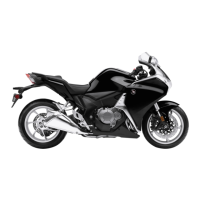
 Loading...
Loading...
Do you have a question about the Honda VFR1200F and is the answer not in the manual?
| Bore and Stroke | 81mm x 60mm |
|---|---|
| Compression Ratio | 12.0:1 |
| Ignition | Computer-controlled digital transistorized with electronic advance |
| Transmission | 6-speed |
| Final Drive | Shaft |
| Front Tire | 120/70 ZR17 radial |
| Rear Tire | 190/55 ZR17 radial |
| Wheelbase | 60.8 inches |
| Seat Height | 32.1 inches |
| Fuel Capacity | 4.9 gallons |
| Engine Type | 1, 237cc liquid-cooled 76° V-4 |
| Fuel System | PGM-FI |
| Front Suspension | 43mm inverted cartridge fork with spring preload adjustability; 4.7 inches travel |
| Rear Suspension | 5.1 inches travel |
| Front Brake | Dual 320mm discs with 6-piston calipers, ABS |
| Rear Brake | 276mm disc with 2-piston caliper, ABS |
| Curb Weight | 591 pounds (Includes all standard equipment, required fluids and full tank of fuel—ready to ride) |
Follow guidelines to enhance riding safety, including inspections and precautions.
Understand safety and information labels on the motorcycle for potential hazards.
Essential precautions for safe riding, including protective apparel and rider awareness.
Guidelines for safe riding, including running-in, brakes, and wet conditions.
Advice on adding accessories and modifying the motorcycle for safety and legality.
Guidelines for safely carrying luggage and cargo on the motorcycle.
Identifies key components and their locations on the motorcycle.
Explains the dashboard instruments, including tachometer, speedometer, and gauges.
Details the function and operation of various switches on the motorcycle.
Step-by-step procedure for starting the motorcycle's engine.
Explains the motorcycle's transmission, shift patterns, and recommended shift points.
Essential reasons for maintaining the motorcycle for safety and performance.
Outlines routine maintenance tasks and their recommended intervals.
Covers basic maintenance practices, including pre-ride inspections and fluid checks.
Guides on how to remove and install various body parts for maintenance access.
Instructions for checking, adding, and changing engine oil and filter.
Information on checking and adding coolant, and recommended coolant types.
Procedures for inspecting brake fluid, pads, and clutch fluid.
Guidance on checking and adding final drive oil.
How to check and adjust throttle cable freeplay for smooth operation.
Adjustments for clutch/brake levers, and front/rear suspension settings.
Diagnoses and solutions for when the engine fails to start.
Addresses overheating issues indicated by the high coolant temperature warning light.
Explains the meaning and response for various warning lights like oil pressure and PGM-FI.
Procedures for emergency tire repair and removing wheels for puncture repair.
Solutions for common electrical issues like dead battery or blown fuses.
Information on ignition keys, spare keys, and key number recording.
Details on ignition switch, engine stop switch, odometer, and document bag.
Guidelines for washing, polishing, and maintaining the motorcycle's appearance.
Recommendations for proper storage of the motorcycle, especially for extended periods.
Instructions on how to safely transport the motorcycle using trailers or trucks.
Advice on environmentally responsible practices when owning and operating the motorcycle.
Location and importance of VIN and engine serial numbers for identification and parts ordering.
Explanation of exhaust, noise, and evaporative emission control systems.
Information on the catalytic converter's function and how to protect it.
Guidance on using oxygenated fuels and their compatibility with the motorcycle.
Information on obtaining service and owner's manuals, including item numbers and prices.
Details on motorcycle warranties, coverage, exclusions, and service procedures.
Key specifications of the motorcycle, including dimensions, weights, and capacities.
Technical service data such as tire sizes, pressures, spark plugs, and oil capacities.
Critical torque values for various fasteners and components during maintenance.